Accepted Scientific Name: Stapelia schinzii var. angolensis Kers
Bot. Not. 122(2): 176 (-177). 1969
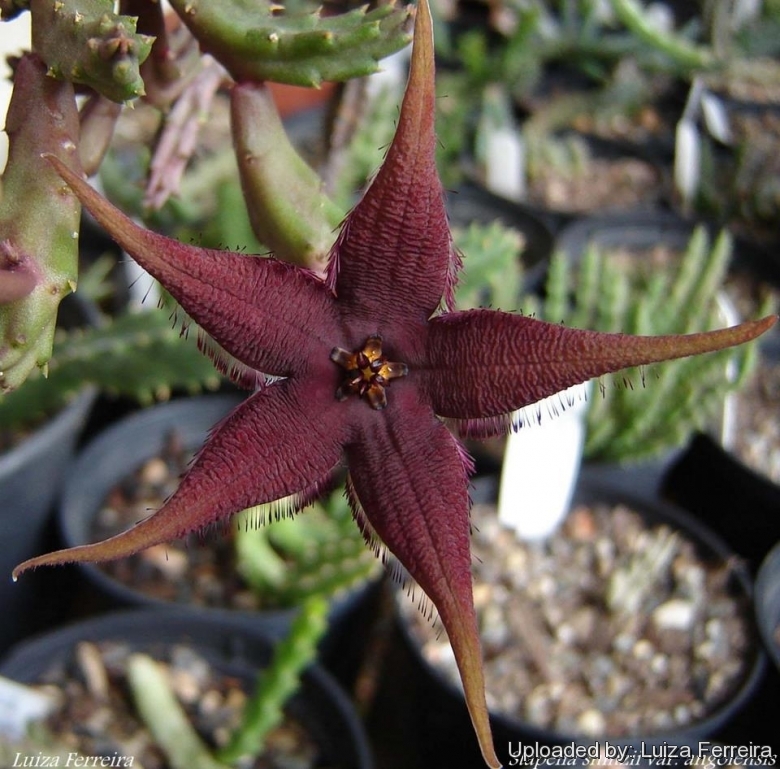
Gonostemon schinzii var. angolensis (Stapelia schinzii var. angolensis) Photo by: Luiza Ferreira
Origin and Habitat: Mocâmedes (Angola, South Tropical Africa, Africa)
Habitat and ecology: Low dry rocks along streams.
Synonyms:
See all synonyms of Stapelia schinzii
back
Accepted name in llifle Database:Stapelia schinzii A.Berger & Schltr.Vierteljahrsschr. Naturf. Ges. Zürich 53(4): 491. 1909 [dt. 1908; publ. 3 May 1909]Synonymy: 3
Accepted name in llifle Database:Stapelia schinzii var. angolensis KersBot. Not. 122(2): 176 (-177). 1969Synonymy: 2
Accepted name in llifle Database:Stapelia schinzii var. bergeriana (Dinter) L.C.LeachExcelsa Taxon. Ser. 3: 74 (1985)Synonymy: 3
back
Description: Stapelia schinziiSN|29668]]SN|29668]] var. angolensis is known by its very handsome and highly curious dark red to maroon flowers with hairs along the edges of the petals. It is similar to var. angolensis, but has generally smaller flowers ( only about 8 cm in diameter) borne on more slender, scarcely toothed stems which adopt a creeping habit. This species and occasional species in other genera (Orbea ciliataSN|23062]]SN|23062]], and Stultitia cooperiSN|32681]]SN|32681]] to name only the most striking) present one of the most fascinating phenomena of plant life, they have clavate and strongly vibratile hairs which form a fringe along the edge of the corolla lobes. These hairs hardly remain still and start trembling in the slightest breeze, possibly attracting insects.
Stems: The stems are creeping, green, mostly purple-mottled and up 6-7.5 cm long, 1.5 cm across, with winged angles, hairless or minutely roughened at first, tubercles decurrent, with a minute tooth at the base of the ultimately marcescent tips.
Leaves: Rudimentary, about 5 mm long, ovate, long-attenuate, delicately roughened, stipular rudiments yellowish.
Flowers: Usually solitary (a second bud aborting), borne on lower half of stem. Peduncle robust, glabrous. Pedicels 5 6 cm, delicately roughened. Sepals 5 8 mm, mostly glabrous. Corolla c. 8 cm cm across, inside hairless, greenish or reddish-brown beneath many close, purplish delicate wrinkles. Limb shallowly concave. Lobes ovate, long acuminate, 3.75 - 8.8 cm long, often caudate, outside more or less glabrous, inside glabrous, fringed with vibratile, purple, club-shaped glandular hairs. Outer corona-lobes dark red or black, usually oblong, c. 4 mm long pointed, sometimes ovate and mucronate, diverging. Inner corona-lobes c. 8 mm high, with erect 3-angled, inner horn and erect, free outer wing as long as the apical append age broad, narrowly ovate-pointed or rectangular, ob-tuse, irregularly dentate, free. Pollinia brownish, 1 x 0.5 - 0.6 mm.
Fruits (follicles): Glabrous.
Chromosome number: 2n = 22
Subspecies, varieties, forms and cultivars of plants belonging to the Stapelia schinzii group
Bibliography: Major references and further lectures
1) Focke Albers, Ulrich Meve “Illustrated Handbook of Succulent Plants: Asclepiadaceae: Asclepiadaceae” Volume 4 Springer Science & Business Media, 2002
2) Kenjiro Fujii “Cytologia” Volume 38 K. Fujii., 1973
3) White & Sloane. “The Stapelieae” edn 2. Abbey San Encino Press, 1937
4) James Cullen, Sabina G. Knees, H. Suzanne Cubey “The European Garden Flora Flowering Plants: A Manual for the Identification of Plants Cultivated in Europe, Both Out-of-Doors and Under Glass” Cambridge University Press, 11/Aug/2011
5) Carl August Lückhoff “The stapelieae of Southern Africa” A. A. Balkema, 1952
6) Leach, L. C. "A revision of Stapelia" L. Excelsa Taxon. Ser. 3: 1–157 1985
7) Werner Rauh “The Wonderful World of Succulents: Cultivation and Description of Selected Succulent Plants Other Than Cacti” Smithsonian Institution Press, 1984
8) Bruyns, P.V. “Stapeliads of southern Africa and Madagascar” vol. 1. Umdaus Press, Hatfield, Pretoria. 2005.
9) Court, D. “Succulent flora of southern Africa” revised edn. Balkema, Rotterdam. 2000.
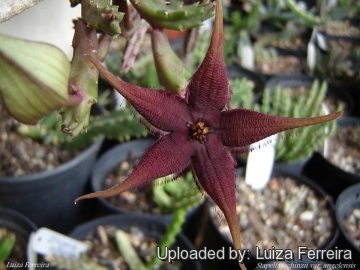 Gonostemon schinzii var. angolensis (Stapelia schinzii var. angolensis) Photo by: Luiza Ferreira
Gonostemon schinzii var. angolensis (Stapelia schinzii var. angolensis) Photo by: Luiza Ferreira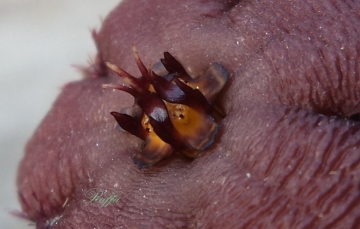 Gonostemon schinzii var. angolensis (Stapelia schinzii var. angolensis) Photo by: Raffa C. Garcia
Gonostemon schinzii var. angolensis (Stapelia schinzii var. angolensis) Photo by: Raffa C. Garcia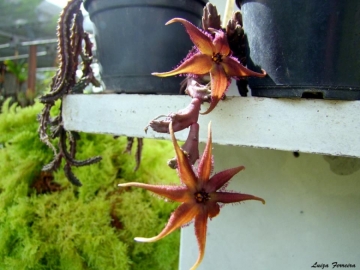 A rare 8-petaled flower. (Stapelia schinzii var. angolensis) Photo by: Luiza Ferreira
A rare 8-petaled flower. (Stapelia schinzii var. angolensis) Photo by: Luiza Ferreira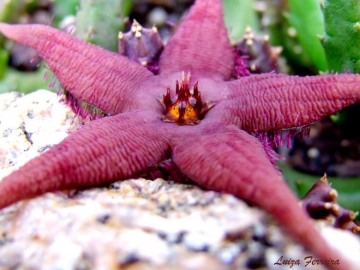 Gonostemon schinzii var. angolensis (Stapelia schinzii var. angolensis) Photo by: Luiza Ferreira
Gonostemon schinzii var. angolensis (Stapelia schinzii var. angolensis) Photo by: Luiza Ferreira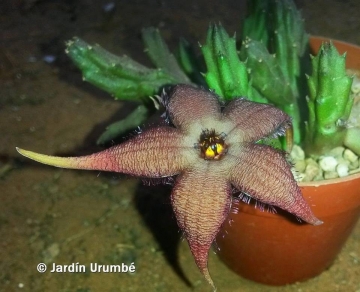 Gonostemon schinzii var. angolensis (Stapelia schinzii var. angolensis) Photo by: Alexander Arzberger
Gonostemon schinzii var. angolensis (Stapelia schinzii var. angolensis) Photo by: Alexander ArzbergerSend a photo of this plant.The gallery now contains thousands of pictures, however it is possible to do even more. We are, of course, seeking photos of species not yet shown in the gallery but not only that, we are also looking for better pictures than those already present.
Read More... Cultivation and Propagation: Stapelia schinziiSN|29668]]SN|29668]] is a very unusual, xerophytic plant adapted to dry soils. It is very suitable for a hanging pot.
Growth rate: It is a somewhat slow growing Stapeliad that will make large clumps given the best conditions. Most plants will offset readily, and clumps can be produced in a few years.
Soils: It likes very porous mineral cactus mix soil, pH 7,5 to 8,5 (mildly alkaline), but can become too elongated if compost is too rich.
Repotting: This plant needs plenty of space for its roots, repotting should be done every other year or when the it has outgrown its pot. Use pot with good drainage.
Watering: It needs regular watering, especially during the hottest summer days; provide also some light watering if the green house temperatures in winter are elevated. Either excessive or very scarce watering can induce rot.
Fertilization: Feed with a high potassium fertilizer in summer.
Frost Tolerance: For safe cultivation winter temperatures must be kept over 10° C, but it can withstand winter night-time temperatures down to about 5°(or less) Celsius for short period. Freezing temperatures are often fatal. In the rest period no high atmospheric humidity!!
Sun Exposure: Best for half-shade but grow well in full sun and full shade too. Tends to bronze in strong light, which encourages flowering, but is likely to suffer from sun scorch or stunted growth if over exposed to direct sunlight during the hottest part of the day in summer.
Diseases: This species is relatively resistant to cryptogamic diseases than others and is quite resistant to the “Balck spot” disease of Asclepiads. Rot it is only a minor problem with Stapelia schinziiSN|29668]]SN|29668]] if the plants are watered and “aired” correctly. If they are not, fungicides won't help all that much.
Uses: It is an excellent plant for container growing. Cascading, clustering, great for a hanging display. Stems may possibly become purple and limp in winter, but revitalize in early spring. It always looks good and stays small. It look fine in a cold greenhouse and frame or outdoor in a rockery.
Propagation: Seeds and cuttings. Cuttings will root only in hot weather. Cuttings must be kept very dry to root. Seeds germinate readily if they are sown when fresh.
















